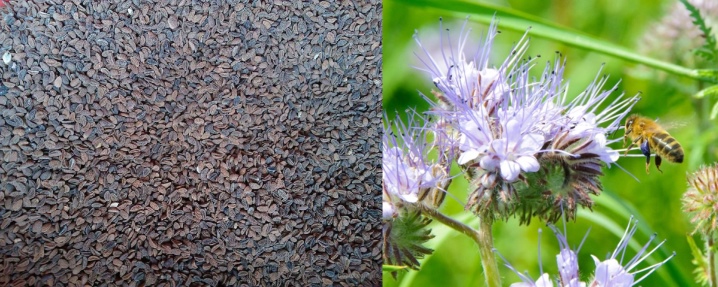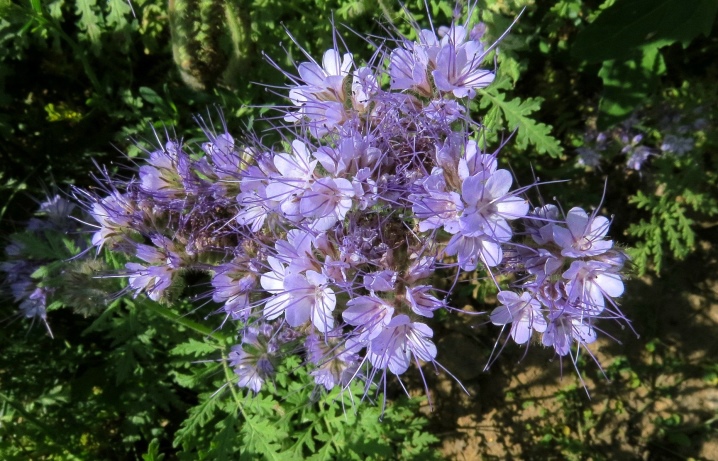How to use phacelia as a green manure?

Recently, more and more gardeners have been using phacelia as a green manure plant. And this is no coincidence - it is the phacelia that is distinguished by its maximum versatility. In the article, we will talk about the beneficial properties of this amazing plant, its varieties, as well as how to properly use phacelia to increase soil fertility in your area.

Benefit
Phacelia was introduced to the European continent 2 centuries ago and by now has won the love and respect of many people for its aromatic flowering, excellent melliferousness and ability to quickly improve the fertility of even the most wasteful lands. In addition to being undemanding to soil conditions, this wonderful herb has a number of attractive properties: long flowering, resistance to low temperatures (withstands frosts up to -8 degrees Celsius), which allows using this plant as a green manure practically throughout the entire territory of our country.
Phacelia are not afraid of diseases, which are considered a real scourge of vegetables and other garden plants, thanks to which it is successfully planted as a predecessor crop for improving the soil and repelling pests.

If you sow phacelia in early spring immediately after the snow melts, you can get from 200 to 300 kg of greens of this plant from one garden weave just before the main plantings... This green manure emerges and grows very quickly, reaching a height of up to 1 m. Its tender aboveground parts decompose after mowing in a matter of days, saturating the soil with nitrogen and other useful elements that are very necessary for plants throughout the summer. Phacelia roots, remaining in the ground, quickly rot, while humus penetrates into the soil, increasing its fertile properties. Dense and airtight clayey soils literally become light and friable before our eyes.
Phacelia has the property of disinfecting the soil, so the cultivated plants planted after it are absolutely not susceptible to late blight, root rot and other dangerous and highly contagious diseases.

And also this The beneficial plant takes care of the harvest by driving out pests such as wireworms, locusts and nematodes from the garden beds. Phacelia nectar, on the contrary, attracts beneficial insects that fight the moth, leafworm, apple blossom beetle and some others. If you plant this green manure in combination with legumes, you can greatly reduce the number of aphids, pea weevil, root weevil and other pests.
Getting into the soil, the phacelia changes its acidity to neutral, due to which some weeds, for example, woodlice, disappear from the garden.

Sow phacelia in the ground you can from early spring to September-October... At the same time, in one season, you can get 4 crops of green mass, while radically changing the soil of your personal plot. Planted in the fall, remaining under the snow in winter, the aboveground part of the plants prevents some crops from freezing, and also protects the soil from erosion and drought.

Views
Currently in Europe, there are up to 180 species of phacelia, however, only three of them are mainly grown: tansy, twisted and bell-shaped. All named species have long flowering period and increased honey content, thanks to which they are very popular among beekeepers.The honey collected from its flowers is considered very valuable due to its particularly beneficial properties, delicate aroma and high content of beneficial amino acids.

Consider a description of these three types of phacelia and find out how they differ from each other.
Tansy
Phacelia tansy, or in another way rowan-leaved, received the most widespread use in our country. It is widely grown as an ornamental plant, a honey plant, in addition, it is this type of phacelia that is considered the best green manure.
The leaves of this species resemble tansy leaves - thanks to such an interesting similarity, the plant got its name.

What does the tansy phacelia look like? This species has erect strong stem, reaching a height of 1 m, on which there are long lateral branches, in turn, bearing shoots of the second order. Bluish-lilac flowers are collected in complex umbellate inflorescences and decorated with long stamens, which gives the flower baskets an even more sophisticated look.
This beautiful plant is developing very quickly, building up a large green mass, due to which the tansy phacelia is most often used as a green manure. This variety blooms a month after sowing seeds in the ground, which usually occurs in May. Due to its beauty and fragrant flowering, the plant is also used in landscape design.

Twisted
Due to the long flowering period - from June to September - this type of phacelia is more used for decorative purposes. Phacelia twisted has shoots up to 50 cm long with pubescent leaves and small numerous twisted blue inflorescences.

Bell-shaped
Phacelia bell-shaped grows up to 25 cm, its flowers look like bells of bright blue and lilac shades. This plant blooms in June. Due to its picturesque appearance, the bell-shaped phacelia used for decorative purposes in landscape design, for example, when creating alpine slides, flowering lawns, and to decorate flower beds.

For what soils is it suitable?
Despite the fact that, in general, green manure takes any soil well, but there are also some nuances here.
- Phacelia does not like strongly acidified soils. On such land, it is better to use another green manure plant, such as buckwheat.
- With insufficient moisture, it does not tolerate highly saline soils with a high content of sodium salts.
- Phacelia does not like areas where water stagnates - this plant tolerates drought better than swampy soils. Due to poor access of oxygen to the seeds and roots of the plant, it may not sprout or die later.

How to grow?
If you want to use phacelia as a green manure in order to improve the soil of your garden, It is best to sow seeds in early spring, just after the snow melts.
It is necessary to make a preliminary mineral fertilizers in order to provide nutrition to the seedlings. Before sowing seeds, the soil is freed from weeds and slightly loosened. Digging or plowing the land is not required.

In order to plant a plot of 1 weave with phacelia, you need to take 100-150 g of seeds.
There are 2 ways to plant the seeds of this green manure: loose and in rows. Since its seeds are very small in size, they should not be planted too deeply into the soil - it is enough to deepen by 1.5-2 cm, pouring abundantly with water after planting. In early spring, immediately after the snow melts, watering is not necessary.
If the plot is large, it is best to plant phacelia by simply scattering the seeds. After sowing, the soil is slightly loosened with a rake.

Often when planting phacelia seeds mixed with sand or sawdust in a 1: 1 ratio. This is done so that there are no unseeded places in the garden: because of the small size and dark color on the ground, the phacelia seeds are very difficult to see.
The sowing of seedlings between the rows of green manure has a very favorable effect on its survival rate and primary growth. This method of growing seedlings, say, tomatoes, protects young plants from winds and scorching sunlight, and after mowing the green manure, the soil is enriched with nutrients necessary for the further growth of the garden crop. It is also productive to grow potatoes, alternating their rows with phacelia.

After harvesting the garden in the fall you can sow phacelia seeds again, leaving the plant for the winter. Seedlings will rot well under the snow, and in spring they will serve as an excellent fertilizer.
In just one season, you can plant phacelia up to 4 times:
- immediately after the snow melts;
- in mid-June;
- at the beginning of August;
- mid September - early October, depending on climate and region.
After mowing the green mass can be put into compost, used for preparing green fertilizer and subsequent irrigation of garden beds, as well as for mulching the beds and row spacing. The cut phacelia is also an excellent food for farm animals and poultry.

How to dig up and mow?
Siderative cultures must be cut before flowering in order to prevent the uncontrolled spread of their seeds throughout the garden. In addition, after flowering, the stems and leaves of the phacelia become coarser and decompose worse after mowing. Another important factor affecting the timing of cutting green manure is the highest concentration of nutrients in the plant before flowering, later this number decreases. Thus, if the task is to enrich the soil with useful substances, it is necessary to cut the plant before the first buds appear on it. This usually happens a month after germination.

Some gardeners cut the phacelia using a flat cutter, then watered with special preparations, contributing to the fastest decay and fermentation. You can also cover the beveled parts with mulch or opaque foil. After a week, the mulch is removed, and you can sow the garden again, after digging up the ground.
Review overview
Those who used phacelia as a green manure are just crazy about this useful and flowering plant. Everyone who has tried phacelia in their garden unanimously affirms: this is, indeed, the most versatile green manure of all known, after all, after it, you can plant any crop without the risk of infection. It is known that cabbage and other cruciferous plants cannot be planted after mustard, and there are no restrictions after phacelia.

And also gardeners note that phacelia forms green mass faster than other green manure plants, which in most cases does not even need to be buried: they simply cut off the stems near the ground and leave them to rot in the garden. Phacelia excellent copes with loosening and increasing fertility even the most neglected soils.
Many people like phacelia due to its decorative properties, in addition, attracting bees increases the yield of vegetables, berries and fruits.

In a word, growing phacelia on your personal plot is both useful and beautiful at the same time.
In the next video, you can learn more about when to sow phacelia and how to use it as a green manure.













The comment was sent successfully.